Archaeologist Dr. Bjarni F. Einarsson is the principal investigator for the archaeological site of Stöð in Stöðvarfjörður, eastern Iceland. The initial overall goal of excavations at the site was to investigate the age of the site, as well as making it more accessible to the public. But the results turned out to be more exciting than expected. Anna Sunneborn Guðnadottir of Scandinavian Archaeology recently sat down with Dr Einarsson to talk about the site, what it could mean for future research, and how Stöð could potentially re-write the settlement history of Iceland as we know it.
Anna: How did you discover the site?
Bjarni: I was surveying for an Icelandic company in the east of Iceland doing construction archaeology for a project that was putting down a fibre optic cable. I knew that Stöð was a farm from Landnám (the Norse settlement period) and was mentioned in Landnámabók (the Book of Settlements) and I could see some ruins in the area. I wrote this in my report, but nothing came of it, until years later when someone from the county contacted me after reading it and was interested in a trial excavation.
A: That’s amazing, and what came of the excavation?
B: I found the Viking Age halls, took some C-14 samples, and when the results came back I decided to create a project. This was in 2015, and I have excavated every summer since.
A: You mentioned that Stöð was mentioned in Landnámabók, care to elaborate?
B: Stöð and its settler [are] only mentioned once, and then they disappear from the sagas. A man called Þórhaddur gamli (Thorhadd the old) came to Stöð. He was from an area close to Trondheim, Norway. The passage indicates that he was a chieftain, and the research we have done at Stöð indicates that Stöð was a chieftain’s residence. It is the richest Viking Age hall that has been found in Iceland, and is richer than the second and third richest combined. There are two other Viking Age chieftain halls in Iceland, Hófstadir I Mývatnssveit and Hrísbrú in Mosfellsdalur. If they are chieftain residences, this is the residence.
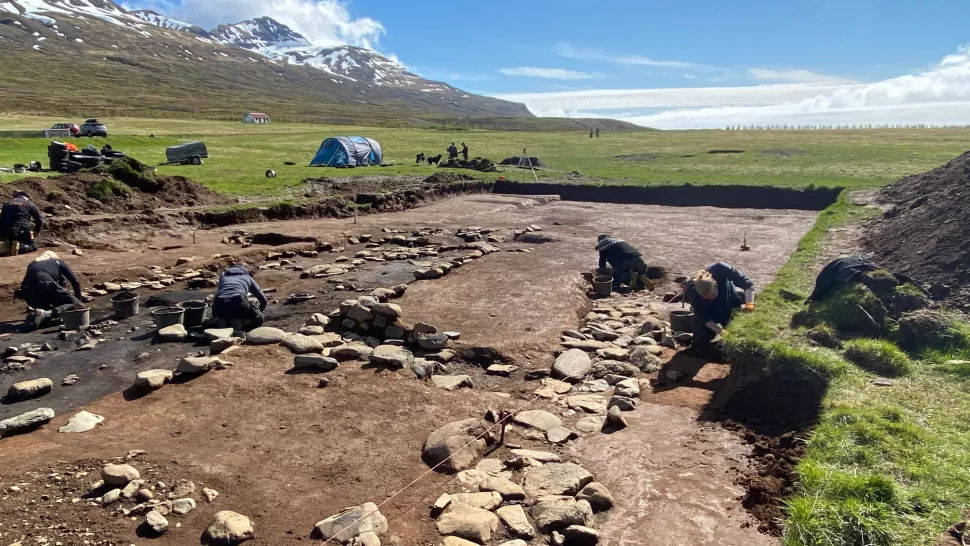
A: You found two longhouses [at Stöð] dating to the Viking Age, correct?
B: Yes, dating to the early 9th c. and late 9th c.—so the younger one [dates] to the accepted settlement age. We have relative dating, tephrochronology [dating based on tephra from known volcanic eruptions], and carbon dating dates that indicate this.
A: And it was the youngest that was the richest one?
B: Exactly, the largest amount of silver, lead, spindle whorls that have been found in a Viking Age hall.
A: One of the things that caught my attention is that you’ve found Middle Eastern coins as well as beads from Europe and Asia. Do you have any theories on how they came to Iceland?
B: Likely through exchange. As a chieftain in Norway, it is likely that he sent ships out south and when he came to Iceland he kept doing it. All the evidence points to exchange.
A: This excavation could potentially re-write Iceland’s history; can you elaborate on that?
B: Yes, and it probably already has. Obviously, I have to finish the excavation and process all the finds, but the current theory is that before the younger house dating to the Landnám period, there was a very big Viking Age hall from the first half of the 9th c. under it. It currently measures 43 m long, but we have not excavated it as it is located below the younger hall—as we call it.
A: What is the old house dated to?
B: I have relative dating and tephrochronology, which indicates that it was built after c. 800 CE, but also before 870 CE. In the younger hall’s turf walls, we can see the so-called “Landnámslag”—which is the tephra layer from a volcanic eruption in the Veiðivötn area in South Iceland that is dated to around 870. In the older house, we cannot find this at all. We have found other tephra layers, but it is slightly problematic because we have not dated any tephra layers with good precision older than the Landnám. In geology, the older tephra layer matters very little, but for us in archaeology that use tephrochronology it is very important, and we are working on it.
A: So, this hall is a Viking hall? This is not the Irish papar that are mentioned in the sagas?
B: Yes, people from northern Europe. The older hall is a classic Scandinavian Viking hall, and we have not completely excavated it, but it is not a farm. Rather an outpost or a workstation. That’s the theory.
A: What does this mean, is it a temporary settlement?
B: The older, yes. We will excavate that one this summer. It seems like there will be less artefacts, but we will see this summer. It is really long and also divided into sections. I have only seen one section and it is likely a smithy. Smithies do not exist in any other hall in Iceland, so this is not a normal hall.
A: As I’m sure our readers would love to know, what is the most fascinating object you’ve found and how old is it?
B: Well, that is a matter of opinion obviously. We’ve found a lot of objects, coins from the Middle East, around 180 beads, two harpoons, an axe, and something I like to call the “mysterious things.” We also found a unique find type, it has been found in other places though: struck jasper and chalcedony, just like people used to strike flint. [These consist of] scrapers, knives and planers, cores and flakes, and we have an expert to identify them for us. We have found closer to 2000 of these.
A: What are the “mysterious things”?
B: They are stone discs that have rarely been found in Iceland before, and the only other place I know of is Norway and the British Isles. They vary in size, are made from different stones, hard and soft, and they’ve commonly been referred to as “gaming pieces” or “game discs” but no one actually knows what it is. They have not been found in Sweden or Denmark, but have been found in Ireland and the Shetland Islands. In Ireland, they are called gaming pieces, on the Shetland Islands they offer no explanation to what they are, and in Norway they are called gaming pieces or unidentified. However, as we found over 90 discs, this seems unlikely to me—unless they were really into gambling.
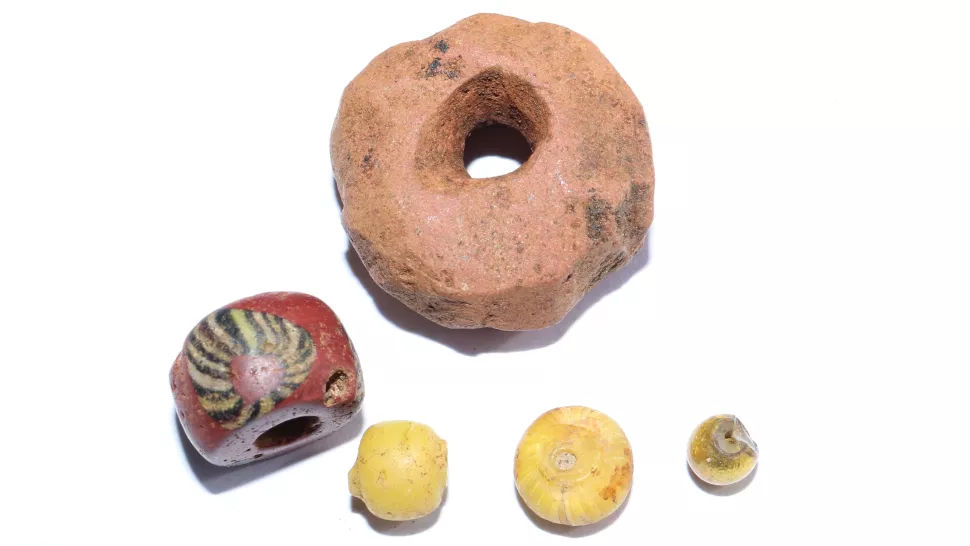
A: So, do you have any theories on what they are?
Bjarni: I think that these discs have something to do with the work that was done there. I think they were hunting whales, and made whale oil and it was part of the export, which was generally used in oil lamps, ships and sails. We know whale blubber (or any other blubber) was not exported in barrels, but rather in sacks made from seals, fish stomachs or other organic material., The sack was tied off, and then a disc was put on top of the knot, and then another knot was tied on top of the disc. This made the sack leak-proof. Seeing as we see this in later times – it is likely that this is the usage of these discs. I obviously need to prove this theory, so to get concrete answers we have two experts coming to Iceland who will be doing DNA analyses this summer. Hopefully we’ll find DNA from whales or seals—it does not really matter to me.
A: Okay, so this was a big export product then?
B: It was the blubber production for all of Europe, and it is likely that the person that came from Norway was part of a similar export from Norway—as blubber was mainly produced in northern Norway. Blubber has played a more important part in history than archaeologists previously believed, however now more and more research on it is being done, as this was the time urban areas and cities were being built in Europe and the blubber was needed for the oil lamps, and it was the north of Norway and Iceland that produced the most of it.
A: How can you prove this?
B: Some people from the University of Copenhagen who specialise in DNA are coming to the excavation this summer. We have already taken a profile from modern times to the oldest time, and the preliminary results show that there are DNA traces from whales in both phases. In the older one we have not found any traces of domestic animals, and very little grass but a lot of wood. In the younger house we found grass, but no wood. This indicates that there were animals in the younger, as we found grass—the food for the animals—but not in the older one as there is no evidence for animals there. This will all be [tested] this summer when the experts come. They will take the older house and treat it like a crime scene, and take a lot of DNA tests. Then we should be able to elucidate it, and hopefully we will not find any domestic animals!
A: And why is it important to not find any traces of domestic animals?
B: If we find traces of cows or horses, then our theory is disproved. It is okay to find pig or sheep as they can be kept on the ships as they were sailing to Iceland during the summer. Then they would have meat for food and wool for fixing the sails if they were to break.
A: What would you say is the most groundbreaking thing that you have found?
B: That would definitely be the oldest, and longest, hall that is dated to the beginning of the 9th c.
A: And the aim for the summer will be to confirm these theories?
B: Yes, the next coming summers. There are a lot of summers left on this project. We are looking for other houses, and a boat house and the grave or graves.
A: So, this an ongoing project, if so what would the next step be?
B: This summer we will excavate the older house and open the areas around some test pits we have done previously. In one of them there is evidence of a house, in another one there is structure – either a production area or an activity area. Then I will look for the boat house and graves. As the valley floor has been researched, we know that the sea used to reach much further up than it does today, all the way up to the houses, maybe further. It seems like the land has been raised about 3-4 m, and the boat house is located by the old seaside, and based on aerial images I can identify something that looks like it. If I can confirm this theory, it will need to be excavated as well and it would be one of the first ones that would be found on Iceland dating to the Viking Age. Then we obviously want to find [a] grave. If we find a grave mound we can expect a very rich grave as it was the home of a chieftain, but as the landscape around the halls has been levelled out, it can be hard to find. Hopefully, we will be able to identify it using LiDAR data, I think I know where to look—but we will see! Then after we finish the excavation, the post-excavation work starts.
Text: Anna Sunneborn Gudnadottir. Copyright 2022 Scandinavian Archaeology.
All images: Bjarni F. Einarsson.
About the author

Anna Sunneborn Guðnadóttir
Archaeologist with a bachelor in archaeology from Uppsala University (Sweden), a Masters from University College London (UK), and a Masters from Uppsala University (Sweden).
During my masters studies I focused on the archaeometric side of archaeology - mainly Geographic Information Systems, geoarchaeology and optical microscopy. In my MA dissertation at UCL I used micromorphology and ceramic petrography to attempt to trace ancient artefacts to its manufacturing location based on modern soil samples and literary sources. My MA dissertation at Uppsala University was a digital analysis of a settlement based on the ceramics found during excavation.
I have a love for all things stratigraphy and geoarchaeological, and can often be found looking at stratigraphy wherever I can find it.
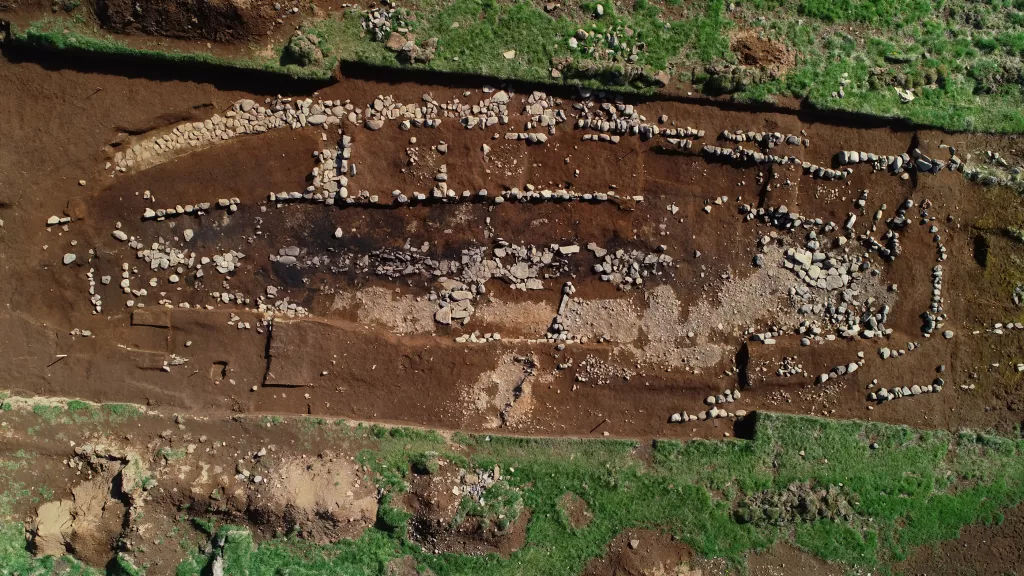
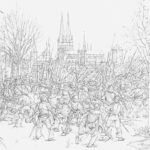
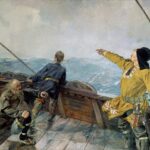
Great article and important find!
Hi Richard,
Thank you and yes, it is indeed an important find that we have had the pleasure of writing about!
Keep up the great work. I hope you guys can keep up making amazing finds like this one. The settlements in Iceland and Greenland have such mistery behind them.
Hi Wilmar,
Thank you very much!
We agree, the settlements in both Greenland and Iceland are so fascinating and we will definitely write more about them in the future!
It was so highly interesting to read this lines of stöð and I am so curious what comes next in summer! If there is need of helpers with the excavation or any other useful tasks in connection with that (shopping, cooking….) I would love to help on volontary basis. Kind regards from Christine
Hi Christine,
We are happy you enjoyed the article! If you are interested in helping you can always reach out to the excavation team.